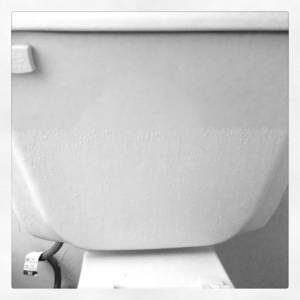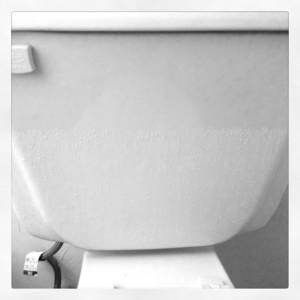Many people—especially those who live in hot climates—accept toilet condensation as a fact of life. Just as we humans sweat, so will anything that holds liquid, from our drinking glasses to our toilets. Many people treat the puddles of water that “sweat” off their toilets during the summer months as a mere nuisance, mopping them up and moving on with their day.
Condensation within the bathroom is far from natural or harmless, however. The moisture which collects on the back side of toilet fixtures can do real, lasting damage to the structure around it.
The water which runs down the back of the toilet not only frequently leads to surface mold, but it can also easily begin to seep under the floorboards (even when mopped up daily, as moisture has a way of getting into the cracks regardless). From there, the water slowly rots the plywood supports under the floor and soaks into the floor joists. At the same time, it tends to stain baseboard molding, turn drywall soggy, and discolor wall paint owing to the presence of mold.

How Toilet Condensation or Sweat Happens
Unless your bathroom is heavily air conditioned, when the weather turns hot and humid, an imbalance is sure to occur; while the outside air surrounding the toilet is sweltering the water inside the toilet tank remains comparatively cool (usually about 50° to 60° Fahrenheit) thanks to the constant circulation that provides the toilet with fresh, cool water.
The meeting of the warm, moist air and the cool porcelain surface causes the tiny droplets of water in the air to condense, and as such, they turn to water and begin to drip onto the floor. Depending on how humid the area you live in is, this can generate a significant amount of water in a relative short time.
Stopping Toilet Sweat
Fortunately, the solution to this problem is relatively simple, provided it is caught early—before it can do any lasting damage to your bathroom.
You don’t have to go to all the added effort and expense of installing an air conditioner or dehumidifier (if you don’t wish to); instead, simply insert a heat exchange system into your toilet so that the water warms up.
Also known as “antisweat valves”, these exchanges reside in the water-supply line leading to the toilet, and continually add a little hot water to the stream entering the toilet, so that its internal temperature matches the external temperature. Voila – no more toilet sweat!
While it’s still important to clean around and under the toilet, as the bathroom is an inherently moist environment, installing a heat exchange should preserve the structural integrity of your bathroom, without requiring any costly alterations to your home.






